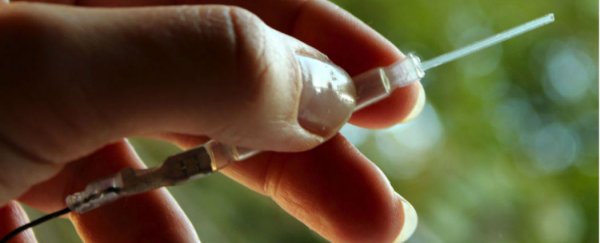A new type of implantable drug pump has been developed by researchers in Sweden, and it's so accurate, it only needs 1 percent of the medication usually needed to treat spinal cord injuries, nerve damage and neurological disorders.
The implant, which is shaped like a tiny tube and measures just a few centimetres long, can deliver a drug dosage molecule-by-molecule, and by closely monitoring its activity, doctors can cut down on side effects, and cost of treatment. "In theory, we could tell you exactly how many molecules our device is delivering," Amanda Jonsson, one of the team and bio-electronical engineer from Sweden's Linköping University, told William Herkewitz at Popular Science. "These very small dosages could help avoid drug side effects, or be useful for medicines that we simply can't use at larger doses."
The technology was designed to solve one of the biggest problems with current drug delivery methods - often medication is only needed in one specific area in the body, but because it's so hard to get to, is administered elsewhere in large doses so that enough makes it to the designated site. But of course, so much medication can lead to serious side effects and a higher cost, and it's not always guaranteed that the correct dosage will make it to the right area anyway.
Now Jonsson and her team have demonstrated how their new drug pump can be inserted into a lab rat and attached to its spine at the root of a nerve, so it can deliver medication for spinal injuries directly to the source of the pain. Herkewitz explains how it works at Popular Science:
"The technology is based on a compact but complicated piece of laboratory equipment called an ion pump. To put it simply, as electric current enters the ion pump one electron at a time, medicine is flung out the other end one molecule at a time. One caveat: Because of this setup, only medicines that can be electrically charged can be used with the pump. But that includes more pain medicines than you might think, including morphine and other opiates."
Publishing in the journal Science, the team describes working with an inhibitory neurotransmitter called γ-aminobutyric acid (GABA), which blocks impulses between nerve cells in the brain for the treatment of anxiety, chronic pain, and epilepsy. They report that a highly localised delivery of a low dose of GABA to rats with spinal injuries resulted in a significant decrease in pain and no observable side effects.
"With any other drug pump this would be ineffective if not insane - the GABA would simply travel throughout the spine at leisure, wreaking widespread havoc and disrupting the nervous system," says Herkewitz. "But, with the ion pump's pinpoint precision, Jonsson could inject incredibly small amount of GABA right where they needed it, without the risk of major damage."
While the team says their pump will need to be adjusted greatly to accommodate long-term use - in its current size, it might actually cause deformations of the spine - but for short-term drug delivery, it appears to work. On rats, at least. The team will now work on perfecting the delivery technique by integrating biomarkers that will tell them exactly where and how much of the drug is being released, and seeing if it's effective in humans. If there's one thing we could improve on, it's how effectively we use the drugs we have, so inventions like this sure are welcome.
